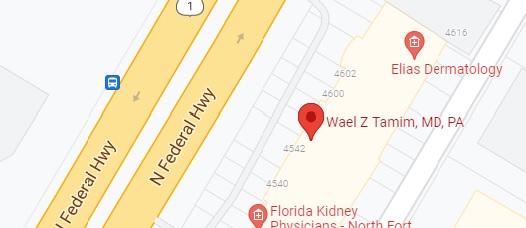
What is Aortic Dissection?
The aorta is the largest artery in the body. It arises from the left ventricle (one of the four chambers of the heart) and supplies oxygenated blood to the entire body. The aorta is divided into the ascending aorta (first part that arises from the heart), aortic arch (middle curved region), and the descending aorta (last section that travels down the chest). The aortic wall is made up of three layers. Weakness in the aortic wall can cause a tear in the inner layer, allowing blood to leak into the middle layer, and separating or dissecting the two layers. This is called aortic dissection. The dissection can sometimes cause a rupture in the outer wall, which can be fatal. An aortic dissection is a rare condition that is most frequently observed in men aged 60 to 70 years of age.
Aortic dissection can be classified into two types based on the location of the dissection:
Type A: This is the more dangerous one and common of the two. The tear occurs in the upper or ascending part of the aorta
Type B: This is less life-threatening than type A. The tear occurs in the lower or descending part of the aorta
Causes of Aortic Dissection
The exact cause of aortic dissection is unknown. However, physicians believe aortic dissection usually occurs in the weakened area of the aortic wall due to certain health conditions and risk factors and sometimes as a result of severe trauma to the chest due to a motor vehicle accident.
Some of the risk factors that are deemed to increase your chances of developing aortic dissection include:
- A family health history of aortic dissection
- High blood pressure
- Atherosclerosis or hardening of the arteries
- Aortic aneurysm
- Aortic valve defect
- A congenital condition such as aortic coarctation
- Genetic disorders such as Turner's syndrome and Marfan syndrome
- Previous heart surgery
- Male gender
- Advanced age
- Lifestyle issues such as smoking and cocaine use
Symptoms of Aortic Dissection
Symptoms of aortic dissection can be similar to those of other heart conditions such as myocardial infarction. Some of the typical signs and symptoms of aortic dissection include:
- Chest pain
- Pain in the upper back
- Shortness of breath
- Dizziness, confusion, or fainting
- Brisk weak pulse
- Stroke-like symptoms
- Profuse sweating
- Difficulty speaking
- Severe pain in the abdomen
- Pain in the leg
Diagnosis of Aortic Dissection
Your doctor will review your medical history and symptoms and conduct a physical examination of the chest using a stethoscope to detect the abnormal heart rhythm. Your doctor may also recommend the following diagnostic tests:
- Magnetic Resonance Angiogram (MRA): This study uses a large magnetic field and radio waves to produce images of the blood vessels.
- Magnetic Resonance Imaging (MRI): This study uses a large magnetic field and radio waves to produce cross-sectional images of the aorta.
- CT Scan: This scan uses multipleX-rays to produce detailed cross-sectional images of the pelvic and groin regions.
- Transoesophageal Echocardiography (TEE): This uses high-frequency ultrasound waves that produce clear images of the heart which is viewed through the esophagus.
- Echocardiogram: Using sound waves the heart’s size, motion and structure is viewed.
Treatment for Aortic Dissection
An aortic dissection is a medical emergency needing immediate treatment. The treatment may include medications or surgery, depending on the section of the aorta involved or the type of aortic dissection.
Medications
In order to treat mild cases of type A or type B aortic dissection, your physician may utilize medications such as sodium nitroprusside (Nitropress) and beta-blockers to help lower your heart rate and blood pressure.
Surgery
The type of surgery depends upon the type of aortic dissection:
- Type A dissection: Your surgeon will remove as much of the damaged aorta as possible and reconstruct the aorta with a synthetic tube called a tissue graft. Your surgeon will also repair or replace the aortic valve if it is leaking and place the valve within the graft utilized to rebuild the aorta.
- Type B dissection: Your surgeon will employ a procedure similar to the one used to repair type A aortic dissection. But additionally, a stent may be placed in the aorta to correct a complicated type B aortic dissection.
Post-treatment, you may need to take life-long blood pressure-lowering medication and your physician may also recommend periodic follow-up scans to monitor your heart condition.
Prevention of Aortic Dissection
Individuals with a genetic or family history of aortic dissection can prevent or reduce the risk of developing aortic dissection by following healthy lifestyle habits, such as:
- Regular heart check-ups
- Regular exercises
- Maintaining healthy body weight
- Refraining from smoking
- Eating a healthy diet rich in vegetables, whole grains, fruits, and low salt
- Regular monitoring of blood pressure and taking treatment for hypertension
- Wearing a seat belt to avert chest injury during a motor vehicle collision
- Following a treatment regimen religiously for any existing medical disorders that can increase your risk of developing aortic dissection
Related Topics:
- Minimally Invasive Heart Surgery
- Atrial Fibrillation Corrective Surgery
- Percutaneous Mitral Valve Repair
- Removal of Masses or Tumors from the Heart
- Aortic Dissection
- Coronary Artery Bypass Grafting
- Aortic Valve Disease
- Aortic Stenosis
- Transcatheter Aortic Valve Replacement - TAVR
- Mitral and Aortic Valve Repair and Replacement
- Tricuspid Valve Disease
- Valvular Surgery


